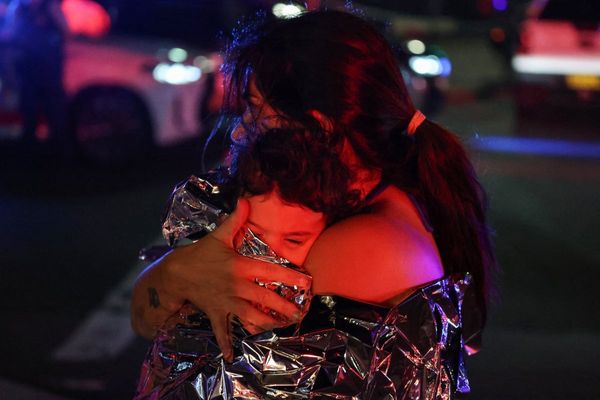
Health authorities in Ohio have alerted in recent days of a paediatric surge of cases of pneumonia in the state.
The Warren County Health District said in a statement on Wednesday that 145 cases of pneumonia have been reported in children between the ages of three and 14 since August. In an initial news release on Tuesday, the health district confirmed that the spreading illness was deemed an “outbreak” due to the above-average case volumes.
Recent media reports have drawn comparisons between the spike in cases of mycoplasma pneumonia, dubbed “white lung syndrome,” in both Ohio and China. But health officials in the state have warned that the outbreak is not linked to China’s — meaning that the strains seen by Ohio doctors are not spreading from country to country.
Although cases have risen in Ohio, medical experts said the trend was somewhat expected as part of the flu season, and that it was potentially exacerbated by COVID restrictions being dropped.
“We have no evidence whatsoever of any connection to any outbreaks statewide or internationally,” said Clint Koenig, a family physician and medical director at the Warren County Health Department. “We don’t have any evidence to suggest this is anything but routine, standard winter bugs causing pneumonia in higher rates in kids.”
Dr Koenig has emphasised that the cases of pediatric pneumonia in Ohio are not a new or novel virus, but rather strains of pneumonia that already circulated in the US. Warren County District reports that most children are recovering at home and no deaths have been recorded in relation to the outbreak.
Here’s a breakdown of what you need to know about both outbreaks — and why officials believe they’re not linked:
What strains of pneumonia are circulating in Ohio?
The Warren County Heath District said the main types of pathogens detected so far were streptococcus pneumonia, adenovirus, and mycoplasma pneumonia.
Meanwhile, cases seen in China include respiratory illnesses such as influenza, rhinoviruses and mycoplasma pneumonia. Cases of mycoplasma pneumonia are also spreading in Denmark, reaching epidemic levels and recoding 541 new cases by the end of last week, according to a Danish Ministry of Health research group.
In recent media reports, mycoplasma pneumonia has been described as “white lung syndrome,” due to the whitening of the lungs shown in x-rays of patients with pneumonia, NBC reports. The term is a medical buzzword and is not used by physicians when treating patients.
Health authorities in the US have been in contact with their counterparts in China. However, medical experts have concluded that the outbreak in Ohio appears to be driven by the usual mix of respiratory viruses during the colder months — all of which previously circulated in the US.
“Despite the headlines that we’re seeing in China, there is no indication that there are any new viruses or bacteria spreading from country to country,” John Brownstein, a doctor at Boston Children’s Hospital, told ABC News. “This is typical seasonal bacterial and viral activity that we see each year.”
The Chinese Health Ministry has also stated that the respiratory illnesses seen in the country are not new and are all known.
What is mycoplasma pneumonia?
Mycoplasma pneumonia is a bacteria that can cause mild infections by damaging the lining of the respiratory system, according to the Centers for Disease Control and Prevention (CDC). Around two million cases are recorded each year in the US.
The infection can become pneumonia, where shortness of breath can also be experienced, but is considered a milder version of pneumonia.
“It’s sometimes referred to as ‘walking pneumonia,’ which means you have pneumonia but you’re not sick enough to be in the hospital,” Associate Professor of Infectious Diseases at UT Southwestern Medical Center Dr James Cutrell told NBC.
In most cases, people can “recover at home and are treated with antibiotics”, the Ohio health district said in its release.
The bacteria is spread through coughs and sneezes and is usually spread between people who spend a lot of time together, such as in households, schools, residence halls, and military or care facilities and hospitals.
In Ohio, the Warren County Health District said most children have been experiencing symptoms such as cough, fever and fatigue. Other symptoms listed by the CDC include a sore throat and headaches. If a child under five contracts the illness, they could also experience sneezing, a stuffy or runny nose, watery eyes, wheezing, vomiting and diarrhoea.
What has driven the outbreak in Ohio?
Bacterial infections such as mycoplasma pneumonia tend to make a resurgence every three to seven years in the US, with cases rising in colder months. Viruses like influenza, RSV, and the common cold follow similar trends.
“Based on our provisional assessment, we are seeing seasonal trends. Nothing is appearing out of the ordinary, but we are continuing to monitor,” said a spokesperson from the Centers for Disease Control and Prevention.
Dr Koenig also noted that although some cases have led to hospitalization, most have been patients with underlying conditions and that the illnesses are no more severe than in previous years.
Restrictions on social interactions being further lifted post-pandemic may have also contributed to the spike in cases. Michael Osterholm, director of the Center for Infectious Disease Research at the University of Minnesota, told NBC that particularly rings true in China’s case.
“They really did have a total shutdown of all the infectious diseases. So I would have expected exactly what we’re seeing right now,” Mr Osterholm said. “We’re seeing increases in respiratory infections in general, but particularly it seems like mycoplasma ... It’s just because we’ve got a larger pool of people who are more susceptible.”
Health officials have recommended that everyone over the age of six months get an updated COVID-19 vaccine and their annual flu shot.
Older adults over the age of 60, pregnant women, and infants under the age of eight months are also eligible for an RSV vaccine to protect against severe illness and death.







